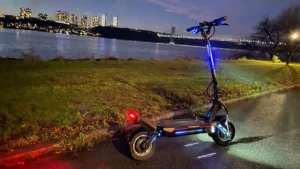In the rapidly evolving landscape of urban transportation, electric scooters have emerged as a sleek, efficient, and eco-friendly solution to the challenges of commuting.
This article explores the electric scooter phenomenon, delving into its features, benefits, and the transformative impact it has on the way people navigate the bustling streets of modern cities.
The Electric Scooter
A Technological Marvel: Electric scooters, propelled by battery-powered electric motors, have become synonymous with the sustainable mobility movement.
Compact, nimble, and emission-free, these two-wheeled wonders are redefining the urban commuting experience for millions.
Key Features and Benefits
- Zero Emissions: Powered by clean and renewable energy sources, electric scooters produce zero emissions during operation. This environmentally conscious design aligns with the global push for greener transportation solutions.
- Cost-Effective Commuting: Electric scooters offer an economical alternative to traditional modes of transport. With lower upfront costs, minimal maintenance, and no fuel expenses, they present a budget-friendly option for daily commuting.
- Last-Mile Connectivity: Electric scooters address the notorious “last mile” challenge of urban commuting. Riders can seamlessly cover short distances, bridging the gap between public transportation hubs and their final destinations.
- Compact and Portable Design: Most electric scooters feature a lightweight and foldable design, making them incredibly portable. Commuters can easily carry them onto buses or trains, store them in offices, and navigate crowded city streets with ease.
- Tech-Integrated Convenience: Many electric scooters come equipped with smart features such as GPS navigation, mobile app connectivity, and even anti-theft mechanisms. This integration of technology enhances the overall user experience.
Considerations for Electric Scooter Users
- Safety First: Adhering to safety guidelines is paramount. Users should wear protective gear, follow traffic rules, and be mindful of pedestrians to ensure a safe riding experience.
- Battery Range and Charging Infrastructure: Understanding the scooter’s battery range and the availability of charging stations is crucial for planning routes. Some cities have established dedicated charging infrastructure, while others rely on users to charge and maintain their scooters.
- Local Regulations: Familiarizing oneself with local regulations regarding the use of electric scooters is essential. This includes understanding where they can be ridden, parked, and any licensing requirements.
- Terrain Suitability: Electric scooters are designed for urban environments, but users should be aware of the terrain. Uneven surfaces, potholes, and steep inclines can impact the scooter’s performance.
Future Outlook
- Advancements in Battery Technology: Ongoing research in battery technology is expected to lead to improvements in range, charging times, and overall scooter performance.
- Expanded Infrastructure: As electric scooters become more popular, cities may invest in enhanced infrastructure, including dedicated lanes and more charging stations, to accommodate the growing demand.
Conclusion
The electric scooter is not just a mode of transport; it’s a symbol of the evolving urban landscape towards sustainability and efficiency.
As more individuals embrace this emission-free, cost-effective, and convenient solution, electric scooters are poised to play a central role in the future of urban commuting.
Riding the current of innovation, these electric wonders are propelling us towards cleaner, greener, and more accessible urban environments.



